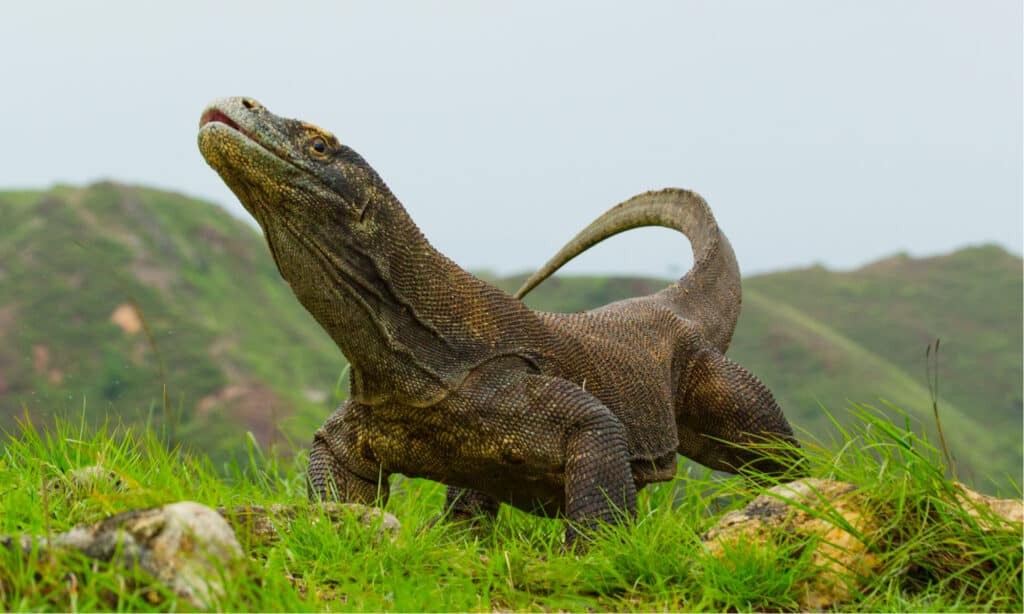The World’s Toughest (and Biggest) Monitor Lizard
Komodo dragons are native to a few islands in Indonesia — Rintja, Padar, Flores, and of course, Komodo. The largest Komodo dragon population lives on Komodo, but they haven’t been seen on Padar since the 1970s. Although there was an estimated population of around 4,000, that number has dropped by more than half — there are only about 1,400 Komodo dragons left in the world.
As a group, monitor lizards have the biggest size variation between species. The short-tailed pygmy monitor is the smallest at about eight inches long. But if you want big, the Komodo dragon is your lizard. The biggest monitor lizard is the biggest of all lizards. They grow nearly 10 feet long and weigh around 150 pounds, but the size record went to a male that weighed 366 pounds.
Yet, Komodo dragons aren’t only big, they are tough.
So tough that the only threat adults face aside from people, is another dragon. To protect themselves from injuries when they combat their rivals, Komodo dragons evolved a specialized type of bony growth in their skin — called an osteoderm. While these are especially common in reptile species worldwide, no other animal has something that can be described as chain mail.

Komodo dragons have bony armor embedded in their skin.
©GUDKOV ANDREY/Shutterstock.com
Osteoderms: Komodo Dragon’s Built-in Armor
If it helps, osteoderm translates as “bone in the skin.” While scientists are unsure how these growths begin, they do know how common they are in nature. Many reptiles grow osteoderms — they turn into scales and bony plates that protect them from environmental hazards and other animals.
Although common in reptiles and a few mammals, osteoderms form differently in different species. Some develop closer to the skin’s surface, whereas others sit more deeply. They can become bony lumps, like a gila monster’s skin, the bony plates on a crocodile’s back, or the hard shell of an armadillo.
Whatever shape they take, these bony growths are versatile!
In Komodo dragons, these grow from head to tail and many overlap slightly, forming that chain mail appearance. They add a tremendous amount of strength to a dragon’s skin and help prevent injuries. According to a 2020 study of Komodo dragons and Gila monsters, they typically contain bone and mineralized collagen.
What Makes the Komodo Dragon’s Osteoderms Different
One big difference between Komodo dragon chain mail and other lizards is quantity. These things cover their bodies from head to tail and nearly everywhere in between. No other animal develops as elaborate and extensive a network of osteoderms as the Komodo dragon.
To get a detailed look at them, the Fort Worth Zoo donated the body of a 19 ½ year-old Komodo dragon and the San Antonio Zoo donated a 2-day-old dragon for study.
Researchers at the University of Texas scanned the specimens using high-resolution X-ray computed tomography (HRXCT). The results were astounding.
In addition to sheer quantity, Komodo dragons’ heads have osteoderms in four different shapes: Worm-like vermiform, sort of rosette-shaped, flat-looking platy, and dendritic.
Komodo Dragons Don’t Hatch with Armor
When researchers scanned the 2-day-old dragon, they discovered it had no osteoderms — which surprised them. Now, the question is, “When do Komodo dragons develop that amazing chain mail armor?”
Young Komodo dragons may not need their own armor yet. Unlike their grown-up relatives, young dragons take to the nearest tree the moment they hatch. They will spend most of their next few years as arboreal lizards, hunting small animals while they grow. These young dragons will stay in their sylvan shelter until they are about four years old and four feet long — big enough to start holding their own.
We can guess that in the four years they spend living in their treetop home, young Komodo dragons begin developing that amazing chain mail armor. However, we don’t know yet. The research team believes scans of lizards at different ages will reveal the answer.

The Komodo dragon’s armor protects them from each other!
©Sergey Uryadnikov/Shutterstock.com
Other Animals with Osteoderms
Osteoderms are amazingly useful structures. In some animals, these bony growths are attached to their skeleton, but not in Komodo dragons. Theirs are purely in the skin.
Versatile enough to protect their owners and help the animal keep warm or release heat, many animals have osteoderms. Pink fairy armadillos are a terrific example. Their shell has blood vessels (is vascular) and the armadillo’s body moves blood into and out of the shell — it’s why these tiny armadillos are called pink. They really are pink when they get overheated because their body moves more blood into the shell area to cool it down.
Here are a few other animals that grow bone in their skin.
- Crocodiles — their armor gives them lateral flexibility (side to side) but not vertical.
- Gila monsters — osteoderms in these lizards look more like bumps all over their bodies.
- All armadillos — theirs are fully attached to their nervous system, muscles, and vascular system.
The photo featured at the top of this post is © USO/ via Getty Images
Thank you for reading! Have some feedback for us? Contact the AZ Animals editorial team.







